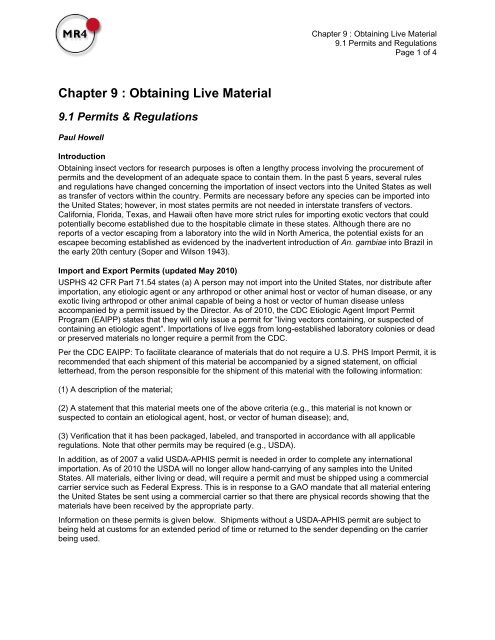Methods in Anopheles Research - MR4
Methods in Anopheles Research - MR4
Methods in Anopheles Research - MR4
- No tags were found...
You also want an ePaper? Increase the reach of your titles
YUMPU automatically turns print PDFs into web optimized ePapers that Google loves.
Chapter 9 : Obta<strong>in</strong><strong>in</strong>g Live Material9.1 Permits and RegulationsPage 1 of 4Chapter 9 : Obta<strong>in</strong><strong>in</strong>g Live Material9.1 Permits & RegulationsPaul HowellIntroductionObta<strong>in</strong><strong>in</strong>g <strong>in</strong>sect vectors for research purposes is often a lengthy process <strong>in</strong>volv<strong>in</strong>g the procurement ofpermits and the development of an adequate space to conta<strong>in</strong> them. In the past 5 years, several rulesand regulations have changed concern<strong>in</strong>g the importation of <strong>in</strong>sect vectors <strong>in</strong>to the United States as wellas transfer of vectors with<strong>in</strong> the country. Permits are necessary before any species can be imported <strong>in</strong>tothe United States; however, <strong>in</strong> most states permits are not needed <strong>in</strong> <strong>in</strong>terstate transfers of vectors.California, Florida, Texas, and Hawaii often have more strict rules for import<strong>in</strong>g exotic vectors that couldpotentially become established due to the hospitable climate <strong>in</strong> these states. Although there are noreports of a vector escap<strong>in</strong>g from a laboratory <strong>in</strong>to the wild <strong>in</strong> North America, the potential exists for anescapee becom<strong>in</strong>g established as evidenced by the <strong>in</strong>advertent <strong>in</strong>troduction of An. gambiae <strong>in</strong>to Brazil <strong>in</strong>the early 20th century (Soper and Wilson 1943).Import and Export Permits (updated May 2010)USPHS 42 CFR Part 71.54 states (a) A person may not import <strong>in</strong>to the United States, nor distribute afterimportation, any etiologic agent or any arthropod or other animal host or vector of human disease, or anyexotic liv<strong>in</strong>g arthropod or other animal capable of be<strong>in</strong>g a host or vector of human disease unlessaccompanied by a permit issued by the Director. As of 2010, the CDC Etiologic Agent Import PermitProgram (EAIPP) states that they will only issue a permit for “liv<strong>in</strong>g vectors conta<strong>in</strong><strong>in</strong>g, or suspected ofconta<strong>in</strong><strong>in</strong>g an etiologic agent”. Importations of live eggs from long-established laboratory colonies or deador preserved materials no longer require a permit from the CDC.Per the CDC EAIPP: To facilitate clearance of materials that do not require a U.S. PHS Import Permit, it isrecommended that each shipment of this material be accompanied by a signed statement, on officialletterhead, from the person responsible for the shipment of this material with the follow<strong>in</strong>g <strong>in</strong>formation:(1) A description of the material;(2) A statement that this material meets one of the above criteria (e.g., this material is not known orsuspected to conta<strong>in</strong> an etiological agent, host, or vector of human disease); and,(3) Verification that it has been packaged, labeled, and transported <strong>in</strong> accordance with all applicableregulations. Note that other permits may be required (e.g., USDA).In addition, as of 2007 a valid USDA-APHIS permit is needed <strong>in</strong> order to complete any <strong>in</strong>ternationalimportation. As of 2010 the USDA will no longer allow hand-carry<strong>in</strong>g of any samples <strong>in</strong>to the UnitedStates. All materials, either liv<strong>in</strong>g or dead, will require a permit and must be shipped us<strong>in</strong>g a commercialcarrier service such as Federal Express. This is <strong>in</strong> response to a GAO mandate that all material enter<strong>in</strong>gthe United States be sent us<strong>in</strong>g a commercial carrier so that there are physical records show<strong>in</strong>g that thematerials have been received by the appropriate party.Information on these permits is given below. Shipments without a USDA-APHIS permit are subject tobe<strong>in</strong>g held at customs for an extended period of time or returned to the sender depend<strong>in</strong>g on the carrierbe<strong>in</strong>g used.
















